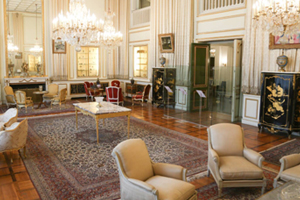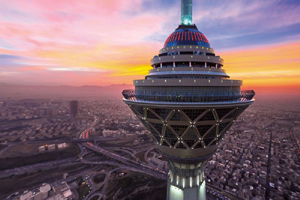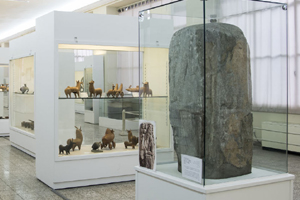The glorious Golestan Palace in Tehran is a masterpiece of Qajar dynasty that depicts the creative integration of Iranian architecture with western influences. Qajar family came to power in 1779 and since then, Tehran was chosen as the capital of their power and the palace was the seat of their government. This palace was built around a garden with picturesque planted areas and a beautiful pool. When you walk into the courtyard, the first thing you see is Takht-e Marmar Terrace. The terrace is ornamented with Iranian elements like mirrors, stuccos, paintings and tile works. There is also a yellow marble throne that came from Yazd. On the right side of the terrace, there is another terrace where Naser al-Din Shah reclined and smoked while enjoying the green surroundings. The integration of Iranian and European architecture is best clear in Shamsol Emare, where the king wanted to have a clear view of the capital, therefore; he got a tower built for him. Though, only its ground floor has remained. There is a theater right on the southern part of Shamsol Emare. It was constructed upon the order of the Qajar king for performing Ta’zieh (Islamic mourning performance). This architectural phenomenon with all of its vibrant and colorful figures and monuments has been registered on UNESCO World Heritage list on 2013.

Iranian kings hadn’t attempted to preserve jewels and ornamental gems before Safavid dynasty. During this period some ambassadors were sent to neighboring countries to purchase and collect jewels and conserve them. After Afghans invasion, some of these jewels were sent to Afghanistan and India, but they were taken back and returned to Iran by brave endeavors of Nader Shah, one of the most powerful Iranian rulers of Persia from 1736 to 1747. He also sent many letters to Indian king to retrieve some of these jewels, but when he didn’t get any answers, he moved his army toward India and took some of these jewels back. During the Qajar era the jewels were collected and some parts of it were fixed on Kiani Crown, Naderi Throne and the gemmed globe and were kept in Golestan Palace. During the rule Reza Shah, the national jewelries first were moved to Marble Palace and then to Bank Melli Iran. The bank later became a museum and today is known as National Jewelry Museum in Tehran. Many Iranian jewels from the Safavid, Afshar, Qajar and Pahlavi periods have been exhibited in this museum. Some world-famous treasures including Daria-i-Noor Jem which means “Sea of light”, Jeghe Naderi, Crown of Farah Pahlavi, Kiani Crown, Sun Throne and Naderi Throne are just some parts of these jewels that are kept in National Jewelry Museum in Tehran.
Situated in the northern part of Tehran, Niavaran Palace was built in an area as wide as 9000 square meters. The whole Niavaran complex consists of some other parts including Private library, Ahmad Shahi Pavilion, Saheb Gharaniyeh Palace and Jahan Nama Museum. The main palace was completed in 1968 and it was the living place of Mohammad Reza Shah and his family, the last Pahlavi King before Iranian revelation in 1980. To reach the palace you should pass through a beautiful garden that has remained from Qajar dynasty. During the rule of Fath-Ali Shah Qajar, this place was a Reed bed (Neyzar), and due to this reason, the garden was called “Ney Avaran” and throughout the time, the region was known as “Niavaran”. The Palace is situated in the northeast part of the garden and depicts Iranian architecture while making use of modern technology. It consists of two floors along with a half floor. The first floor was designed to accommodate guests, and the second floor included the family's private bedrooms and living room. The half-floor was used as the office and also it was the room of the smallest member of the Pahlavi family, Leyla Pahlavi. Niavaran Palace is decorated with exquisite collection of painting by Iranian and foreign artists, along with many decorative items in every corner of the palace.
Sa'dabad Palace, neighboring Darband Mountains in north of Tehran, was initially built during Qajar period, though in Pahlavi dynasty, it outranked Golestan complex as the royal residence. This cultural and historical complex covers an area as wide as 110 hectares, and includes 20 buildings, each for a special purpose, of which Green palace and White palace are the two mostly visited ones. Sa’dabad Palace has passed through four historical periods including Qajar, Pahlavi I and Pahlavi II, and after that the Islamic Republic. It was the summer resort of royal family at first, but after Persian coup d'état in 1921, it was occupied by Pahlavi family and many buildings and structures were constructed there. Currently, some parts of Sa’dabad Palace have been reformed into a museum, where many historical artifacts and documents are displayed and visitors can feel the rich culture and history of Iran. The Special House is another building in this palace and it is currently used by the presidency organization to host foreign diplomats.
Milad Tower is the name of a multi-purpose telecommunication tower located in the northwest of Tehran, the capital of Iran. This tower with 435 meters height is the tallest tower in Iran and the sixth tallest telecommunication tower and nineteenth tallest structure of the world. Due to the height and the unique appearance, the tower is almost visible from everywhere of the city, and hence it becomes one of the symbols of the capital. Milad Tower is one of the capital’s new tourist attractions and has a great capacity for cultural, artistic and commercial activities. Revolving Restaurant, VIP restaurant, mechanical floors, a closed observation deck, a sky dome, an open observation deck, a public art gallery and a cafeteria are just some of these capacities. The conference halls of the tower are among the best halls in the whole Middle East. Dolphinarium, bike riding, paintball and 6D cinema are other attractions of the tower. The Dolphinarium in Milad Tower is the first and only non-coastal dolphinarium in Iran that attracts a large number of visitors who love these intelligent animals.
With aging more than 70 years, National Museum of Iran in Tehran contains 300,000 historical objects. The museum is considered not only as the largest museum of archeology in the country, but also as one of the most distinguished museum in the world concerning diversity and quality of its monuments and objects. National Museum consists of two building, the first one is "Muze-ye Iran-e Bastan" where ancient Iranian antiquities before Islamic era are exhibited, and the second one is ("Muze-ye Dowran-e Eslami") and it displays Islamic objects and monuments. Impressive masterpieces collected from major archaeological sites of the country including Kashafrud, Darband, Ganj Par, Shush and Persepolis are exhibited in this museum. André Godard and Maxime Siroux, the French architects who designed National Museum, were inspired by Kasra Palace in Ctesiphon from Sassanid dynasty. Eventually, the museum was built with ancient Iranian architecture featuring entrances, Iwans and arches found in Sassanied dynasty.
Impressive Azadi Tower was established in 1971 in Tehran to memorialize the 2500th anniversary of the first Persian Empire. Since then the tower has become the symbol of Tehran. The tower was designed by Hossein Amanat, and its architecture is a combination of the Achaemenes, Sassanid, and Islamic periods. The monument was formerly known as Shahyad Tower, but its name was changed after the Iranian Revolution in 1980. This three-story structure has four elevators, as well as a staircase. There are several salons, galleries, libraries and museums in the basement. It might be interesting to know that 8000 pieces of white marble have been used in constructing this tower. Hossein Amanat, the architect of the tower stated that “the tower mirrors the glory of Iranian history, the time when Persia was the pioneer of literature, art, architecture, handicraft and various science. I wanted to do my best in constructing the tower, so that whoever comes from abroad or even Iranians know where and which culture this monument comes from”.
Gate of the National Garden in Tehran was constructed at the beginning of 19th century on the order of Reza Shah Pahlavi. This gate is one of the symbols of Tehran and is visited by many tourists every day. This precious monument was the entrance of Mashgh Square, and it was designed with a combination of Iranian and European architecture, especially the tile working of the pavilion. Pictures of occupying Tehran in 1920 overthrow, along with the angels of victory and Cossack’s soldiers are illustrated with tiles on the gate. A room is located over the arch, where soldiers were taught martial music. Islamic design and pictures, machine guns, battlefield, Shah’s gun, Iranian flag, tiger, as well as Quranic verses and Imams’ name are inscribed under the pavilion. Images of Cyrus the Great and people of that era are also architected in the interior design. Gate of the National Garden was made of cast iron in three pieces). This structure was registered as a national heritage in 1997 and was renovated in 2015.







